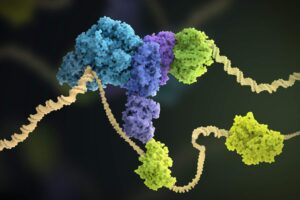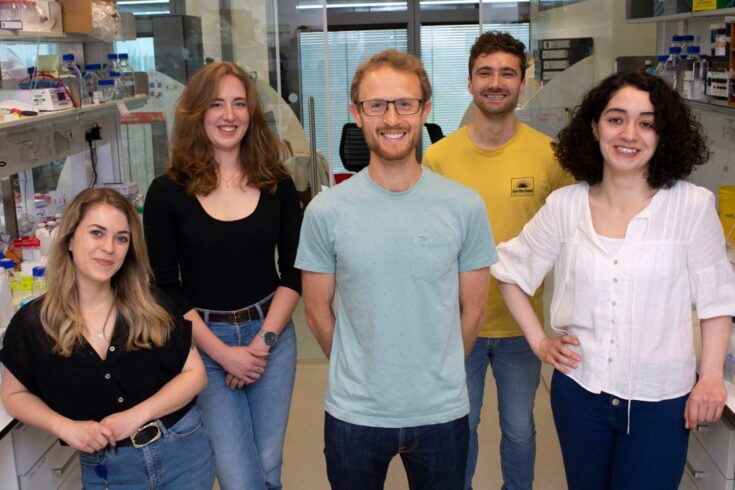Scientists have recreated the protein machinery that normally replicates human DNA within a cell, so it can function and copy DNA in a test tube.
Every time a cell replicates into two cells it needs to produce an extra copy of its DNA. It does this using a complex array of proteins that come together to form a replisome.

DNA being replicated. Credit: MRC Laboratory of Molecular Biology
Being able to study human DNA replication in detail in the lab is very important as errors in the process can produce mutations in DNA, which can cause many diseases, especially cancer.
Now, researchers at the Medical Research Council (MRC) Laboratory of Molecular Biology, in Cambridge, UK, have for the first time recreated a functional human replisome.
It was able to replicate DNA at the same speed as when it happens naturally.
To do so, they had to bring together 11 proteins, made from 43 polypeptide building blocks.
Components of the replisome
Until now, the closest to human replisomes that scientists had been able to recreate and study were yeast replisomes.
In this study, published in Nature, the scientists report how recreating a human replisome in the lab enabled them to determine which components of the replisome are necessary for different functions. This includes speed of replication.
They also identified key unexpected differences with yeast replisomes.
Unprecedented new insights
Dr Joe Yeeles, from the MRC Laboratory of Molecular Biology, who led the research, said:
Reconstituting a functional replisome from purified human proteins is an important breakthrough because it enables us to directly study human DNA replication without interference from the many other complex processes going on inside a cell.
This has the potential to reveal unprecedented new insights into this fundamental process.
Many cancer treatments interfere with the process of DNA replication.
By gaining a deeper understanding of the human replisome through biochemical reconstitution we should be able to develop strategies to specifically target different parts of the replication process, which could help develop better, more targeted cancer therapies in the future.
Tools to find out
Yasemin Baris, first author on the paper, said:
It is very exciting that you have the total control on what you have put into the system and see what it does.
Now we have the tools to find out the functions of many different human replication factors.
Development of future therapies
Dr Megan Dowie, Head of Molecular and Cellular Medicine at MRC, which funded the study, said:
This is an exciting and ground-breaking study, which provides an important molecular platform for the study of DNA replication in humans.
The MRC is committed to funding this type of world-class fundamental discovery science, which has potential to inform development of future therapies in relevant diseases such as cancer.
Building more complexity
The replisomes contained the same basic components as a human cell would use. However, they were assembled on model DNA molecules in a different process to how a cell naturally brings the components together and activates them.
Their next steps will be to build more complexity into the process to further study all the factors that influence DNA replication, such as DNA modifications and chromatin.
Read more about the recreation of functional human replisome and this breakthrough study.
Top image: Credit: MRC Laboratory of Molecular Biology

